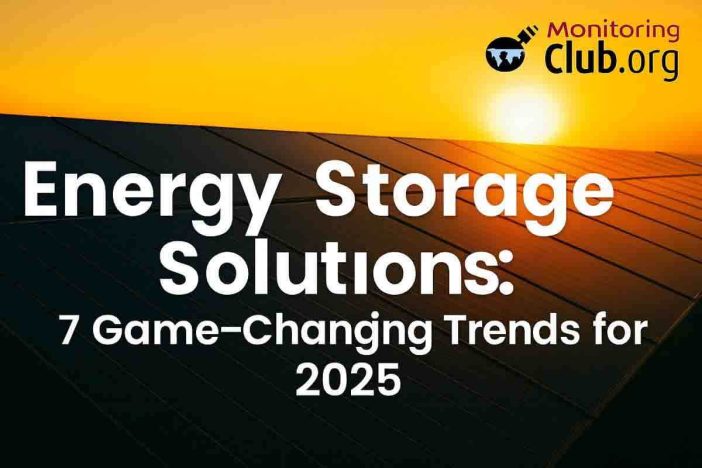
It’s a humid night in Jakarta. The city hums under the weight of a blackout — elevators stuck, lights out, fans silent. But in a few homes and offices, lights still flicker gently. Behind the walls, a quiet hum continues — batteries are working silently. These are Energy Storage Solutions, invisible guardians that keep power flowing when everything else stops.
In 2025, the energy storage sector is crossing a defining threshold. What used to be a niche technology has now become the backbone of renewable power and grid resilience. Here are the 7 game-changing trends transforming the future of energy storage worldwide.
Energy Storage Solutions Game-Changing Trends
1. Market Explosion & Global Expansion
The global energy storage market is exploding. In 2023, total installed capacity nearly tripled year-over-year, driven by massive renewable integration and declining costs.
By 2024, analysts project the global market will exceed USD 668.7 billion, on track to surpass USD 5.1 trillion by 2034.
Leading markets like China, the United States, and the European Union are scaling large-grid storage systems, while emerging economies — from India to Southeast Asia — are accelerating pilot projects that combine solar and storage.
This global surge means more than just investment figures; it’s a transformation of how nations think about energy reliability, independence, and security.
2. Solid-State Batteries Revolution
The next frontier in energy storage is here: solid-state batteries.
Unlike traditional lithium-ion cells, these use solid electrolytes, eliminating the risk of leakage or fire while offering higher energy density, faster charging, and longer lifespans.
Major automakers and tech giants are racing to commercialize solid-state designs. Toyota, QuantumScape, and Samsung have all reported breakthroughs expected to reach market maturity by 2026.
These batteries are not just for electric vehicles — they promise safer, lighter, and more durable stationary storage systems that can power entire neighborhoods.
3. Long-Duration & Grid-Scale Storage Growth
As renewable generation grows, the challenge shifts from producing energy to storing it for long periods. Long-duration storage (LDS) systems — capable of discharging energy for 10+ hours — are key to balancing grids powered by solar and wind.
Technologies like flow batteries, compressed air energy storage (CAES), thermal energy storage, and hydrogen-based systems are moving from experimental stages to commercial deployment.
Countries like the U.S., U.K., and Australia are investing heavily in grid-scale storage plants, providing multi-day backup capacity. In 2025, long-duration energy storage will be the most vital component of achieving 24/7 clean power.
4. Hybrid Renewable Integration (Solar + Storage + Wind)
The future of renewables is hybrid. Instead of separate solar or wind systems, developers now design integrated hybrid plants that include battery energy storage systems (BESS) to smooth fluctuations and store surplus power.
For instance, solar farms now feed excess daytime power into large battery banks that discharge it at night, while wind turbines recharge the same systems during off-peak hours.
Smart inverters and AI-driven grid management make this seamless — reducing curtailment losses and improving overall grid efficiency.
In 2025, hybrid integration will no longer be experimental — it will become the default model for large-scale clean energy infrastructure.
5. Cost Decline & Efficiency Breakthroughs
According to BloombergNEF (2024), the average cost of lithium-ion batteries fell to USD 115 per kWh, the lowest in history.
This cost revolution allows residential and commercial users alike to adopt storage at unprecedented rates.
Efficiency gains come not only from chemistry but also from thermal management, AI-based charge optimization, and next-generation inverter design.
With storage systems now lasting over 15 years and round-trip efficiency exceeding 90%, energy storage is rapidly reaching economic parity with fossil backup systems.
6. Policy & Investment Momentum
Governments and investors are fueling this transformation.
- The U.S. Inflation Reduction Act includes massive incentives for battery manufacturing and installation.
- The European Union’s Green Deal accelerates funding for grid storage and energy independence.
- Asia-Pacific nations are launching renewable integration mandates to ensure storage is paired with new solar and wind projects.
Private capital follows the same trajectory — venture funds and institutional investors are pouring billions into startups innovating around materials, AI optimization, and grid software.
Policy alignment and investment momentum together make 2025 the tipping point for global adoption.
7. Circular Economy & Battery Recycling Innovation
As storage deployment skyrockets, end-of-life management becomes crucial. The focus of 2025 is a sustainable, circular battery economy.
Advanced recycling facilities now recover up to 90% of lithium, cobalt, and nickel, reducing the need for new mining and mitigating environmental damage.
Companies like Redwood Materials and Li-Cycle are pioneering closed-loop recycling, where old batteries are reborn into new ones.
In parallel, research into eco-friendly electrode materials and second-life applications (e.g., using retired EV batteries for home storage) ensures that energy storage supports — rather than harms — the environment.
Practical Takeaways
- For homeowners and communities: start small with modular battery systems integrated with solar panels.
- For developers and utilities: embrace hybrid systems combining long-duration and grid-scale batteries.
- For policymakers: create adaptive tariffs and incentives that reward storage adoption and recycling.
- For investors: watch for emerging players in solid-state and flow battery markets — these are the decade’s biggest opportunities.
Wrap Up – Powering the Silent Revolution
The story of energy in 2025 is no longer about generating more—it’s about storing smarter.
From massive grid installations to compact home batteries, Energy Storage Solutions are rewriting how the world captures, controls, and consumes power.
Each of these seven trends represents a cornerstone of the clean-energy era: smarter grids, safer batteries, cleaner materials, and more resilient communities.
As the world races toward net-zero, one truth remains:
the future of energy doesn’t hum in turbines — it waits, quietly charged, inside the batteries that never sleep.



